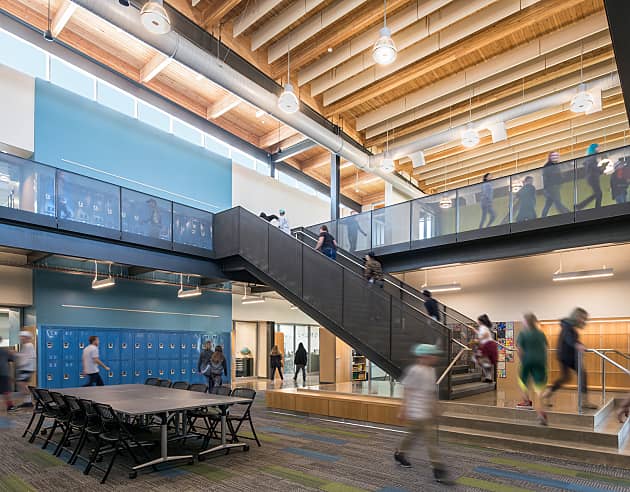- Project uploaded by Stuart Kernaghan on 05-30-2023
- Project last updated by WoodWorks on 06-10-2024
Ta'talu Elementary School
Surrey, BCTa’talu Elementary School will be the first three-storey, hybrid mass timber school in British Columbia, which is significant because building codes had previously only allowed for two-storey combustible (i.e. wood) construction for schools of this size. Extensive work with local regulatory authorities made it possible for the design team combine mass timber with steel and still meet code requirements.
A second unique feature of Ta’talu is the fact that it was designed to be net zero operational carbon ready – another first in British Columbia. Ultimately, however, the school did not receive the funding necessary to be built to that standard.
This 5,051m2 facility will house 80 kindergarten students and 575 grade 1-7 students, plus on-site childcare. The school was gifted the name “Ta’talu” by the Semiahmoo First Nation, which means Little Campbell River; the interior and exterior design have taken inspiration from the river and its surrounding environment.
The building will consist of three stories of stacked learning neighbourhoods on the east and west ends; each neighbourhood is made up of four or five classrooms opening onto a shared project space.
Between the stacked learning neighbourhoods is the shared program. It includes a learning commons, multi-purpose room, administration areas, and a gym, all of which are connected by a central atrium. The atrium and shared program form the heart of the school, providing wayfinding and visual connection for students.
Due to the current status of the British Columbia building code, which does not allow for three-storey interconnected combustible schools, the team was required to come up with an alternative solution to all-mass timber construction.
That will be accomplished using a mix of mass timber, light wood framing, and steel. The predominant structure will be post-and-beam glulam, with light wood framing, and load-bearing beams and columns will be mass timber. Flooring assemblies will be made of non-combustible materials, while shear walls will be light wood framing. Steel construction will be used for the stairs, elevator, and gymnasium.
The drive to use mass timber came out of the school district’s desire to reduce carbon emissions for its new building; that impetus was strong enough for the district to fund mass timber on its own when the provincial education ministry decided not to support this approach.
The design team also recognized that reducing embodied carbon is the next big step forward that the design and construction industry needs to take to advance sustainability goals. An embodied carbon analysis comparing the new hybrid building with a full steel structure option proved the hypothesis that wood would reduce carbon emissions. The total global warming potential of the steel version of the building would be 283kg/m2 CO2eq, which was 27 kg/m2 CO2eq (9.5%) higher than the hybrid version.
Notwithstanding the desire for a lower carbon footprint, aesthetic, biophilic and enhanced learning properties of wood construction also factored into the decision to go the mass timber route. Exposed wood throughout the school will make for a healthier, happier, and more productive environment for students and staff alike.
Project Details
-
Year Built
2024
-
Number Of Stories
3
-
Bldg system
Mass Timber
-
Square footage
54000
-
Construction Type:
IV-HT
-
Building Type:
Educational
-
Material Types:
Mass Timber
Cross-Laminated Timber (CLT)
Glue-Laminated Timber (GLT or glulam)
Hybrid (wood with steel or concrete)
Coatings
Fasteners / Hardware
Project Team
-
Fast + Epp Structural Engineers
-
Western Archrib Glulam Supplier
-
AME Group Mechanical Engineers
-
DGS Construction General Contractor
-
O'M Engineering Electrical Engineers
-
School District No 36 Owner
-
Thinkspace Architecture Planning Interior Design Architect
- Project uploaded by Stuart Kernaghan on 05-30-2023
- Project last updated by WoodWorks on 06-10-2024



 WOODWORKS
INNOVATION
NETWORK
WOODWORKS
INNOVATION
NETWORK






